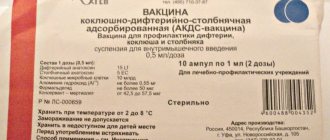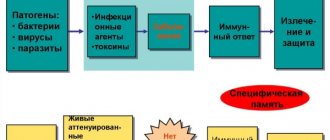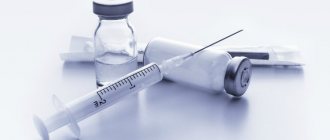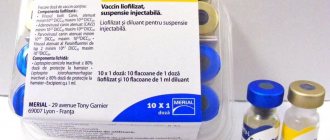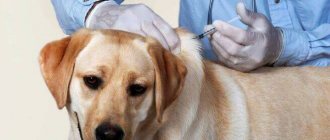Instructions for use of the Rabikan anti-rabies inactivated vaccine
dry culture from the Shchelkovo-51 strain for dogs and cats
(Developer organization: FKP “Shchelkovo Biocombine”, Moscow region)
I. General information
International non-proprietary name - inactivated dry culture anti-rabies vaccine from the Shchelkovo-51 strain for dogs and cats (Rabican).
Dosage form - lyophilized mass.
The vaccine is made from β-propiolactone-inactivated rabies virus strain “Shchelkovo-51” with the addition of 33.3% sucrose-peptone-gelatin stabilizer.
In appearance, the vaccine is a dry, porous mass of yellowish-brown color, which, when sterile distilled water is added in a volume equal to the volume of the vaccine in the vial before drying, dissolves within 1-2 minutes to form a transparent yellowish-brown liquid.
The vaccine is packaged in 2 packs; 4 or 10 cm3 (1; 2; 5 doses for large breed dogs or 2; 4; 10 doses for cats, puppies and adult dogs of small decorative breeds) in bottles of appropriate capacity, hermetically sealed with rubber stoppers reinforced with aluminum caps.
The vaccine vials are packaged in boxes with dividing partitions to ensure their integrity. Each box of vaccine contains instructions for its use. Boxes with the vaccine are packed in boxes or corrugated containers.
The shelf life of the vaccine is 24 months from the date of release, subject to storage and transportation conditions. After the expiration date, the vaccine is not suitable for use.
The vaccine is stored and transported in a dry, dark place at a temperature of 2°C to 8°C or at any sub-zero temperature.
It is allowed to transport the vaccine in the packaging of the manufacturer at a temperature not exceeding 25°C for no more than 10 days.
The Rabican vaccine should be stored out of the reach of children.
Vaccine in vials without markings, with a violation of the integrity and/or tightness of the closure, with a changed color and/or consistency, with the presence of foreign impurities, with an expired expiration date, as well as vaccine residues not used within 4 hours after opening the vials are subject to discarding and disinfection by boiling for 30 minutes or treating with a 2% alkali solution or a 5% chloramine solution (1:1) for 30 minutes. Vaccine vials, syringes and needles are treated in the same way.
Disposal of decontaminated vaccine does not require special precautions.
II. Biological properties
The vaccine causes the formation of an immune response to the rabies pathogen in primary vaccinated animals from 5-7 days after a single injection of the vaccine; immunity reaches its maximum by 30-40 days and lasts for 1 year. In the case of a two-time vaccine administration, with revaccination after 30-50 days, immunity lasts for 2 years.
The immunogenic activity (immunogenicity index) of the vaccine is at least 1 IU/cm3.
The vaccine is harmless and has no medicinal properties.
III. Application procedure
The vaccine is intended for preventive and emergency vaccination of dogs and cats against rabies.
It is prohibited to vaccinate animals suspected of having rabies.
Dogs and cats are subject to vaccination starting from 2 months of age. Vaccination is carried out in compliance with the rules of asepsis and antiseptics.
Before use, the dry vaccine is reconstituted to the original volume indicated on the label with sterile distilled water.
The drug is administered subcutaneously. The injection site is wiped with a 70% solution of ethyl alcohol or another disinfectant solution. A separate needle is used for each animal.
The vaccine is administered in doses (per injection):
- dogs of large breeds (shepherds, St. Bernards, etc.) - 2 cm3;
- puppies (up to 1 year) and adult dogs of small decorative breeds (lapdogs, dachshunds, Spitz, terriers, etc.) - 1 cm3;
- cats - 1 cm3.
Rabikan anti-rabies vaccine for cats and dogs
Rabies is a fatal disease caused by a specific pathogen, the rhabdovirus Rabies lyssavirus.
This is a typical zoonotic infection. The manifestation of its clinical signs means that there is no chance of salvation. Separately, it is worth considering a remedy that can help - Rabican, but this is a little lower. The main source of rhabdovirus is zoophages (carnivores). Therefore, vaccination of dogs and other domestic animals is mandatory and is carried out free of charge in state veterinary institutions.
Don't miss the chance to reliably protect yourself and your loved ones from this merciless disease! After all, a person usually becomes infected with the rabies virus after being bitten by a sick four-legged family pet.
Remember: medicine knows of only a few cases of recovery of people who were given this terrible diagnosis. So all cat and dog owners should unconditionally vaccinate their pets.
But which vaccine should you choose?
Biological properties
- Being an effective means of preventing rabies in dogs, it forms super-active immunity to the rhabdovirus Rabies lyssavirus.
- After a single injection, immune resistance is developed already on days 5-7, which reaches its final formation after 30-40 days and persists for 12 months.
- A two-time injection with an interval of 30-50 days will ensure immunity stability at the level of 0.5 IU for at least 2 years.
- The drug is completely harmless: not a single case of any side effects has been recorded.
Application procedure
It is prohibited to use the dog rabies vaccine if infection with rhabdovirus is suspected.
The simultaneous use of Rabican in combination with other immunoprophylactic drugs, as well as its administration before/after 10 days during vaccination with antiviral drugs, is prohibited.
Vaccination of kittens and puppies is carried out starting from two months of age. Subcutaneous injection is performed in the withers area in compliance with antiseptic requirements:
- the injection site must be wiped with 70% ethyl alcohol or another antiseptic;
- A separate needle should be used for each pet.
The dosage of the drug depends on the dimensions:
- one-year-old puppies and miniature dogs are given 1 ml of vaccine;
- large dogs - 2 ml;
- cats (with any parameters) - 1 ml.
Before use, the contents of the bottle are diluted with distillate, restoring the dry vaccine to the volume indicated on the label.
Preventive measures against rabies in dogs consist of eradicating the disease within settlements and improving the health of areas infected with rabies infection.
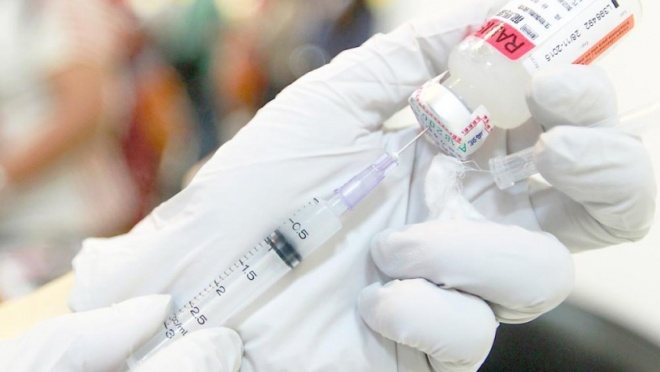
In areas free from rhabdovirus, a single preventive immunization is carried out. Re-introduction of "Rabican" is carried out after a year; further revaccination scheme is 1 time every 2 years. If rabies infection has been introduced into these areas, then the animals are immunized without observing the one-year interval between the 1st and 2nd vaccinations.
In unfavorable areas, immunization is carried out twice with a break of 30-50 days. After this, a single revaccination is carried out once every 2 years. Those pets that have been vaccinated previously are vaccinated once every 2 years.
Emergency (forced) therapeutic and prophylactic vaccination in case of suspected infection is carried out within 48 hours. "Rabican" is administered twice with a two-week break in the dosages recommended for immunization.
Rabies inactivated liquid culture vaccine from the Shchelkovo-51K strain, 1 dose (HeBF)
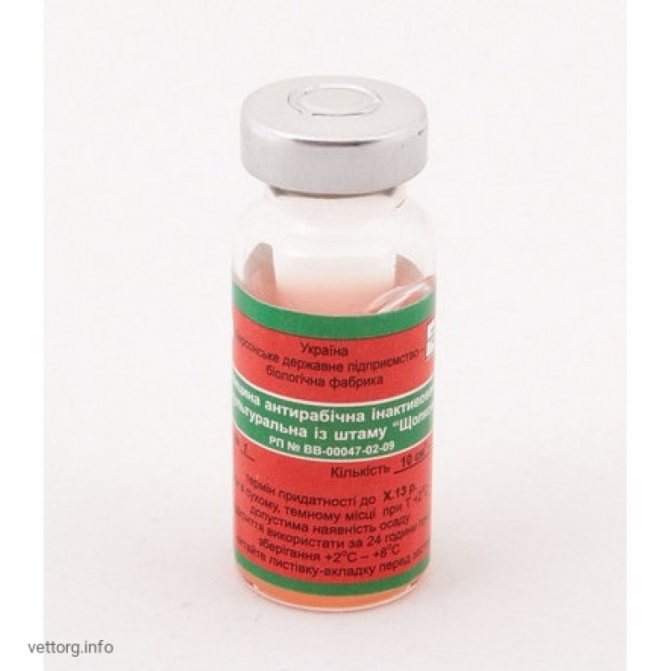
- Manufacturer:
Kherson State Biofactory - 0
- ATC-vet classification code:
QI07AA – Inactivated viral vaccines. Dogs
- Types of animals:
cows, bulls, heifers, calves, horses, foals, pigs, piglets, sheep, lambs, goats, kids, dogs, puppies, cats, kittens, rabbits, fur-bearing animals
- Registration certificate (Ukraine):
ВВ-00047-02-09
- Registration in Ukraine is valid until:
25.12.2019
- Description
- Characteristics
Composition: inactivated β - propiolactone (0.025%) rabies virus, strain “Shchelkovo-51K” ≥ 2 IU; 3% aluminum hydroxide - 15% (as an adjuvant). Pharmaceutical form: Liquid from yellow-pink to pink-red color, there may be a slight gray-white sediment, which, when shaken, breaks into a uniform suspension. Immunobiological properties: After using the vaccine, animals develop immune protection against the rabies virus. Type of animals: Dogs, cats, goats, sheep, cattle, horses, pigs, camels. Indications for use: The vaccine is used for preventive and forced vaccination of animals against rabies. Contraindications: Do not vaccinate animals with signs of illness. Cautions for use: Before using the drug, conduct a visual inspection. Vials without labels, cracks, or mold are prohibited from use. Only clinically healthy animals are subject to vaccination. Animals suspected of having rabies should not be given the vaccine. Before administration, the vaccine is warmed to the animal’s body temperature. The vaccine injection site is treated with an alcohol solution. Do not use frozen vaccine. Annual vaccination is possible depending on the epizootic situation in the territory and state legislation. Interaction with other drugs: It is not recommended to use another vaccine within 14 days before and after vaccination. Do not mix with other vaccines and immunological drugs. Special instructions during pregnancy and lactation: No restrictions. Method of administration and doses: Vaccination of animals is carried out once in the following doses: 1 cm3 subcutaneously for puppies, kittens from 3 months of age; 1 cm3 subcutaneously for dogs and cats; 2 cm3 subcutaneously for sheep, goats, cattle, camels; 2 cm3 intramuscularly to pigs, horses.
| Types of animals | Minimum age for vaccination | Re-introduction | Revaccination (after the last administration) |
| Carnivores | From 3 months | After 12 months | Every 24 months |
| Horses | From 6 months | After 12 months | Every 24 months |
| Ruminants | Over 3 months of age | Mandatory at 10-12 months of age | Every 24 months |
| Pigs | Over 4 months of age | After 12 months | Every 24 months |
Revaccination of animals is carried out once every two years. In case of forced vaccination, the vaccine is used no later than the first day from the moment of contact with animals suspected of being infected with rabies - 4 times: 3 days, 1 dose 1 time per day; after 16 days, 1 dose once. Animals that have not previously been vaccinated against rabies can be vaccinated according to the following scheme: twice with an interval of 21 days at the specified dose; immunity with such vaccination occurs 21 days after the second vaccination and lasts for at least 24 months. Side effects: No changes were detected in the animals' bodies when the vaccine was administered. Overdose (symptoms, emergency care): There are no side effects when a double dose of the vaccine is administered. Waiting period: Zero days. Special warnings for persons and service personnel who use VIP: Service personnel must wear special clothing before vaccination. If the vaccine gets on your skin, wash with soap and water. Special safety measures when handling unused VIP, methods for its disinfection and disposal: Unused vaccine is disinfected by boiling for 15 minutes. Shelf life: 18 months from the date of manufacture. After first opening, use within 24 hours if stored at 2°C to 8°C. Storage and transportation conditions: Store at a temperature of 2°C to 8°C in a dry, dark place out of reach of children. Do not freeze. Transported by all modes of transport in accordance with the requirements of GOST 17768 and “Rules for the transportation and preservation of veterinary drugs, substances, prepared feeds, feed additives, and veterinary medicine in veterinary pharmacies, their structural units, bases, warehouses, etc.,” approved by decree of the State Department of Veterinary Medicine of Ukraine under No. 44 dated August 13, 2002 and registered with the Ministry of Justice of Ukraine under No. 719/7007 dated August 30. 2002 r. Packaging: The vaccine is produced in glass vials with vaccine volumes of 1, 2, 5, 10, 15, 20, 50, 100 cm3. Additional information: It is recommended to carry out antiparasitic treatment of animals no later than 2 weeks before vaccination. After vaccination, no earlier than 14 days later, it is recommended to conduct a serological blood test to determine the presence of antibody titers. If the drug does not meet the requirements of the package insert or complications arise, the use of this series is immediately stopped and the State Scientific Control Institute of Biotechnology and Microorganism Strains (GNKIBSHM) and the supplier (manufacturer) are notified. Simultaneously with the envoy, three unopened bottles of this series of the drug are sent to the State Scientific Research Institute of Biomedical Medicine, according to the “Instructions on the procedure for filing complaints for biological drugs that are intended for use in veterinary medicine” dated 06/03/98 No. 2 to the address: 03151, Kiev, st. Donetskaya, 30, GNKIBSHM. Name, location of the owner of the registration certificate and manufacturer: Kherson State Enterprise - Biological Factory, Ukraine, 73011, Kherson, st. Admiral Makarov, 9.
| ATC-vet classification code | QI07AA – Inactivated viral vaccines. Dogs |
| Types of animals | cows, bulls, heifers, calves, horses, foals, pigs, piglets, sheep, lambs, goats, kids, dogs, puppies, cats, kittens, rabbits, fur-bearing animals |
| Registration certificate (Ukraine) | ВВ-00047-02-09 |
| Registration in Ukraine is valid until | 25.12.2019 |
| Active ingredients | inactivated rabies virus |
Tags: inactivated rabies virus
Release form, composition and packaging
International nonproprietary or chemical name:
Anti-rabies inactivated dry culture vaccine from the Shchelkovo-51 strain for dogs and cats (Rabican)
Marketing authorization holder:
FKP "Shchelkovsky Biocombinat", 141142, Moscow region, Shchelkovo district, Biokombinat village
Developer:
FKP "Shchelkovsky Biocombinat", 141142, Moscow region, Shchelkovo district, Biokombinat village
Manufacturer:
FKP "Shchelkovsky Biocombinat", 141142, Moscow region, Shchelkovo district, Biokombinat village
Dosage form:
lyophilisate for the preparation of injection suspension
Qualitative composition and quantitative composition of active ingredients and qualitative composition of excipients:
The vaccine is made from a fixed rabies virus strain “Shchelkovo-51” inactivated by p-propiolactone with the addition of 33.3% sucrose-neptone-gelatin stabilizer.
Dosage:
2 cm3 (1 or 2 doses), 4 cm3 (2 or 4 doses), 10 cm3 (5 or 10 doses)
Quantity in consumer packaging:
2 each; 4 or 10 cm3 (1; 2; 5 doses for large breed dogs or 2; 4; 10 doses for cats, puppies and adult dogs of small decorative breeds, respectively) in bottles
General information
Against the backdrop of many anti-rabies drugs, the domestic “Rabican” stands out so clearly with its impeccable characteristics that international experts included it among the top three.
The developer of this effective serum is the largest Russian manufacturer of immunological drugs - the Shchelkovsky Biocombine, created in the Moscow region in 1924 on the basis of the Kashintsevskaya breeding farm.
Over 90 years of successful activity, the bio-combine has established the production of over 100 species - against foot-and-mouth disease, plague, brucellosis, etc. High-quality "Rabikan" has added to the list of achievements of the enterprise.
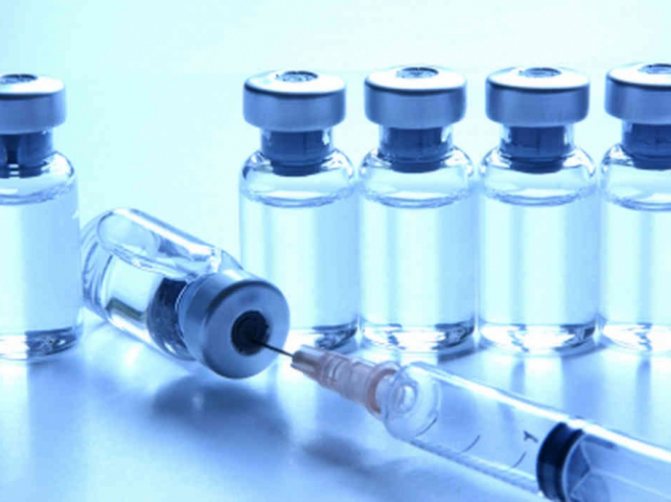
The dosage form of this rabies vaccine is a light gray homogeneous suspension with the main active ingredient, which was obtained as a result of special processing of the fixed rhabdovirus strain "Shchelkovo-51". When settling, a loose sediment may form.
Release form: lyophilized mass, packaged in hermetically sealed labeled bottles with a volume of 10 cm³ to 200 cm³, which is 1; 2; 5 doses intended for large breed dogs, or 2; 4; 10 doses intended for cats, puppies and small breed adult dogs.
The dry mixture should be diluted in a 1:1 ratio with distillate directly in the bottle itself. The mixture dissolves completely within two minutes. The immunogenicity index of the anti-rabies drug is 1 IU/cm³.
Storage and transportation of “Rabican” is carried out at temperatures from +2°C to +8°C in a dry, dark place. The drug in the manufacturer's packaging is allowed for transportation for 10 days at a temperature not higher than +25°C. If it has been frozen, its use is strictly prohibited. Shelf life: 24 months.
It must be disposed of in the following cases:
- if it is in depressurized bottles without markings and without a label;
- has a color that does not meet the standard, a changed consistency, or foreign impurities;
- if the period has expired (counted from the date of issue);
- if the remaining vaccine after vaccination has not been used for 4 hours.
Bottles with rejected/unused medication should be filled with water and boiled for 10 minutes.

Syringes, needles and vaccine vials are disinfected for half an hour by boiling or soaking in a 2% alkali solution or 5% chloramine (1:1).
